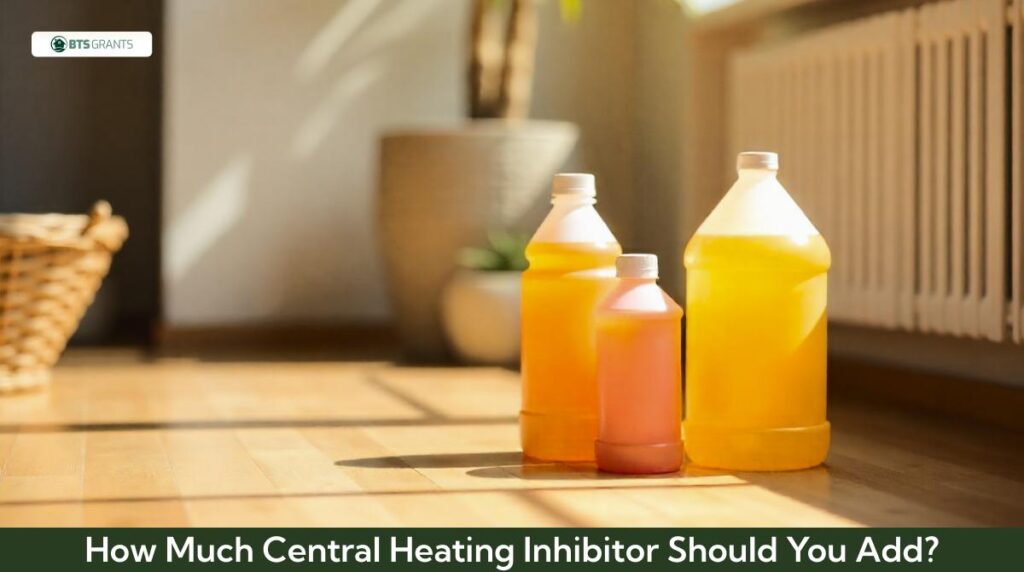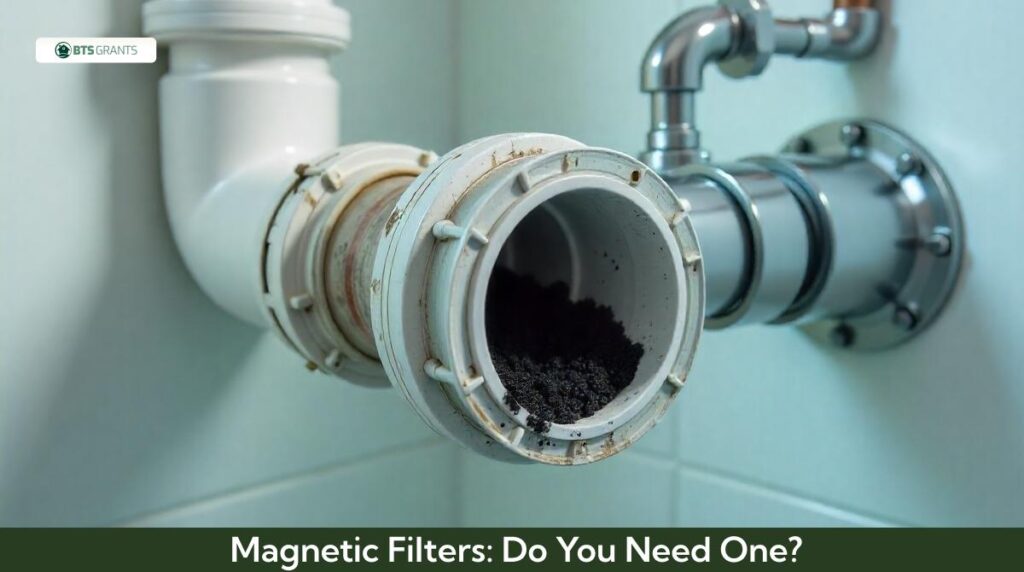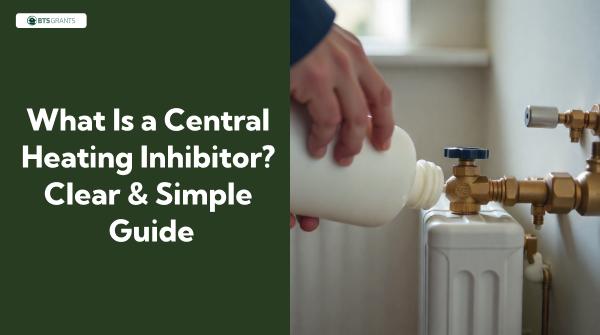You’re not alone if your boiler or radiators have ever suffered from cold spots, corrosion, or frequent breakdowns. Central heating systems face ongoing issues from sludge, rust, and limescale. The solution? Use a central heating inhibitor.
This strong chemical additive, which is also called a heating inhibitor or boiler inhibitor, protects your central heating system by keeping your boiler, pipes, and radiators in good shape. In this guide, we’ll explain what an inhibitor is, how it works, how much to use, and why every home in the UK needs one.
What Is a Central Heating / Boiler Inhibitor?
A boiler inhibitor, central heating inhibitor, or central heating inhibitor is a chemical liquid that moves with the water in your central heating. It inhibits lime scale, sludge, and rust.
Imagine it as a barrier that protects. Without it, your radiators and pipes are continually exposed to oxygen and minerals within the water, which lead to scale and rust. Ultimately, this lowers efficiency, makes radiators take longer to heat up, and could break your boiler.
By adding an inhibitor for heating systems, you’re essentially giving your home’s heating a shield that keeps everything running smoothly.
What does a central heating inhibitor do?
A corrosion inhibitor for central heating does three basic jobs:
- Prevents corrosion – Dissolves oxygen molecules to keep rust from forming within radiators, pipes, and boilers.
- Reduces sludge – It dissociates iron oxide particles, suspending them so they don’t clog pumps or radiators.
- Controls limescale – In areas where hard water is prevalent, inhibitors also function as a descaler, keeping minerals from depositing on heat exchangers.
Whether you call it a rad inhibitor, radiator inhibitor, or inhibitor boiler, the principle is the same: the chemical makes sure water inside your system stays “clean” and protective.
How Much Central Heating Inhibitor Should You Add?


One of the most common questions is: how much inhibitor do I need?
General guidance is:
- 250ml protects up to 6 radiators.
- 500ml is suitable for 7–10 radiators.
- 1 litre works for 11–15 radiators.
- 1.5–2 litres may be required for very large homes.
So, how much inhibitor for 7 radiators? The answer is typically 500ml. However, always check the manufacturer’s label for dosage instructions.
Radiator Recommendation Table with Prices
| Radiator Count | Bottle Size (Approx.) | Coverage | Estimated Price Range (UK) | Notes |
| Up to 6 radiators | 250ml | Small systems | £10 – £15 | Flats or small homes |
| 7 – 10 radiators | 500ml | Medium systems | £15 – £20 | Standard UK houses |
| 11 – 15 radiators | 1 litre | Large systems | £20 – £30 | Bigger properties |
| 16+ radiators | 1.5 – 2 litres | Extra-large | £30 – £40+ | May require 2 bottles |
Pro tip: If you’re unsure about sizing, it’s better to slightly underdose and test the system later than to overdose. Most DIY outlets, including central heating inhibitor Screwfix, stock a variety of options.
How to Add a Central Heating Inhibitor to Different Systems
A common homeowner question is: how to put an inhibitor in a central heating system or how to add an inhibitor to a central heating system. The answer depends on the type of system you have.
Step-by-Step Process (General)
- Turn off your heating and allow the system to cool.
- Check the number of radiators to decide how much inhibitor do I need.
- Identify the correct entry point (feed tank, filling loop, or radiator).
- Slowly add the inhibitor.
- Run the heating so the inhibitor for central heating circulates evenly.
Open-Vented Systems
- Go to the feed-and-expansion tank in the loft.
- Pour the required amount of inhibitor boiler directly into the tank.
- Allow the system to circulate for several hours.
Sealed / Closed Systems
- Use a filling loop or dosing adaptor.
- Attach the bottle or cartridge and inject the heating inhibitor directly.
- Re-pressurise the system if needed.
Combi Boilers
- Add the inhibitor radiator treatment through a radiator valve using a dosing cartridge.
- Bleed air from the radiator afterward to avoid trapped air.
Whether your query is how to add an inhibitor to a central heating system or how to put a central heating inhibitor in the system, the process is straightforward if you follow the product instructions.
What’s the Best Central Heating Inhibitor?
Selecting the best central heating inhibitor will rely on your system size and water quality.
- Liquid inhibitors – Common and easiest to pour in.
- Cartridge inhibitors – Cleaner application, best for sealed systems.
- Concentrate forms – Have to be diluted, but can protect more radiators per ml.
When shopping around for products, look at:
- Compatibility with your boiler type.
- Protection against both corrosion and limescale.
- Length of time protection lasts (some last up to 5 years).
- Manufacturer approval (some boiler warranties require specific inhibitors).
Most inhibitor central heating treatments from reputable brands will work well. If not sure, seek the opinion of a heating engineer. Always choose a product compatible with your system, whether you have a traditional boiler, system boiler, or combi boiler.
Common Issues Avoided by Central Heating Inhibitors
Omitting a heating system inhibitor can result in expensive problems:
- Sludge buildup – Causes radiators to get hot unevenly.
- Boiler failures – When corrosion damages parts like pumps and heat exchangers.
- Problems with pressure – Blockages cause pressure to drop.
- Leaks – Rust corrodes pipes in the long run.
- Scale damage – Hard water deposits solid formations.
Adding a central heating inhibitor is far cheaper than repairing or replacing damaged components.
Magnetic Filters: Do You Need One?


A magnetic filter sits on your boiler’s return pipe and catches magnetic sludge (iron oxide) before it re-enters the system. While a radiator inhibitor prevents corrosion, the filter physically traps existing debris.
Benefits include:
- Cleaner system water.
- Fewer boiler breakdowns.
- Longer life for pumps and heat exchangers.
Installing both a rad inhibitor and a magnetic filter gives your heating system maximum protection.
Scale Reducers and Other Add-ons
In hard water areas, limescale can be just as damaging as sludge. Scaling renders heat surfaces less conductive, hence making boilers work harder.
If you use a scale reducer along with your boiler inhibitor, it does it all. These devices prevent the buildup of minerals, which enhances the chemical action of your radiator to perform optimally.
A full central heating protection system has inhibitors, filters, and scale reducers that all work together.
Safety & Best Practices
Keep these safety tips in mind when using a central heating inhibitor:
- Wear gloves and safety glasses at all times.
- Bottles should be stored out of reach of children and pets.
- Never mix two different brands unless the manufacturer confirms compatibility.
- Test inhibitor levels every 12 months (kits are available).
- Top up after flushing or major maintenance.
If in doubt, get professional help rather than guessing.
FAQ’S
Yes, without it your system is at risk of corrosion, sludge buildup, and limescale damage, which can shorten boiler lifespan.
Yes. Many products are designed to be injected directly into a radiator or filling loop without draining.
You may experience cold spots in radiators, frequent breakdowns, leaks, or even full boiler failure.
Indications are colored water when bleeding radiators, clanking boilers, or repeated sludge. A test kit checks the levels of concentration.
Depending on your system, add it via the loft tank, filling loop, or a radiator valve. Instructions vary, so always check the label.





